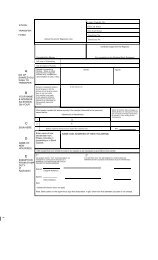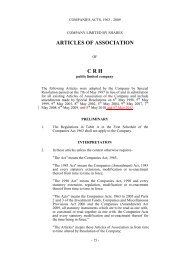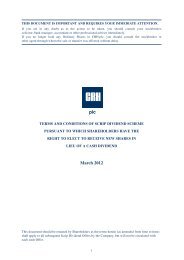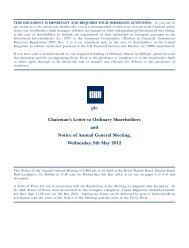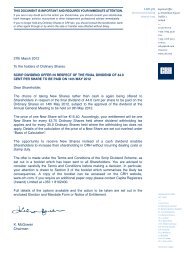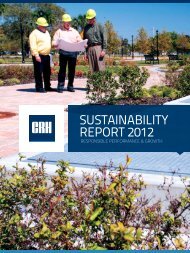2009 Annual Report - CRH
2009 Annual Report - CRH
2009 Annual Report - CRH
- TAGS
- annual
- www.crh.com
Create successful ePaper yourself
Turn your PDF publications into a flip-book with our unique Google optimized e-Paper software.
indicate that the carrying values may not be recoverable. Where the carrying<br />
values exceed the estimated recoverable amount (being the greater of fair value<br />
less costs to sell and value-in-use), the assets or cash-generating units are<br />
written-down to their recoverable amount. In assessing value-in-use, the<br />
estimated future cash flows are discounted to their present value using a pre-tax<br />
discount rate that reflects current market assessments of the time value of money<br />
and the risks specific to the asset for which the future cash flow estimates have<br />
not been adjusted. The estimates of future cash flows exclude cash inflows or<br />
outflows attributable to financing activities and income tax. For an asset that does<br />
not generate largely independent cash inflows, the recoverable amount is<br />
determined by reference to the cash-generating unit to which the asset belongs.<br />
Repair and maintenance expenditure<br />
Repair and maintenance expenditure is included in an asset’s carrying amount or<br />
recognised as a separate asset, as appropriate, only when it is probable that<br />
future economic benefits associated with the item will flow to the Group and the<br />
cost of the item can be measured reliably. All other repair and maintenance<br />
expenditure is charged to the Consolidated Income Statement during the financial<br />
period in which it is incurred.<br />
Borrowing costs re items of property, plant and equipment<br />
Borrowing costs incurred in the construction of major assets which take a<br />
substantial period of time to complete are capitalised in the financial period in<br />
which they are incurred.<br />
Business combinations<br />
The purchase method of accounting is employed in accounting for the acquisition<br />
of subsidiaries, joint ventures and associates by the Group.<br />
The cost of a business combination is measured as the aggregate of the fair<br />
values at the date of exchange of assets given, liabilities incurred or assumed and<br />
equity instruments issued, together with any directly attributable expenses.<br />
To the extent that settlement of all or any part of a business combination is<br />
deferred, the fair value of the deferred component is determined through<br />
discounting the amounts payable to their present value at the date of exchange.<br />
The discount component is unwound as an interest charge in the Consolidated<br />
Income Statement over the life of the obligation. Where a business combination<br />
agreement provides for an adjustment to the cost of the combination contingent<br />
on future events, the amount of the adjustment is included in the cost at the<br />
acquisition date if the adjustment is probable and can be reliably measured.<br />
Contingent consideration is included in the acquisition balance sheet on a<br />
discounted basis.<br />
The assets and liabilities (and contingent liabilities, if relevant) arising on business<br />
combination activity are measured at their fair values at the date of acquisition. In<br />
the case of a business combination which is completed in stages, the fair values<br />
of the identifiable assets, liabilities and contingent liabilities are determined at the<br />
date of each exchange transaction. When the initial accounting for a business<br />
combination is determined provisionally, any adjustments to the provisional values<br />
allocated to the identifiable assets and liabilities (and contingent liabilities, if<br />
relevant) are made within twelve months of the acquisition date.<br />
Minority interest is stated at the proportionate share of the fair values of the<br />
acquired assets and liabilities recognised; goodwill is not allocated to the minority<br />
interest. Subsequently, any losses applicable to the minority interest in excess of<br />
the minority interest are allocated against the interests of the parent.<br />
Goodwill<br />
Goodwill is the excess of the consideration paid over the fair value of the<br />
identifiable assets and liabilities (and contingent liabilities, if relevant) in a business<br />
combination and relates to the future economic benefits arising from assets<br />
which are not capable of being individually identified and separately recognised.<br />
Goodwill applicable to jointly controlled entities is accounted for on the basis of<br />
proportionate consolidation and is therefore included in the goodwill caption in<br />
the Consolidated Balance Sheet, net of any impairments assessed in accordance<br />
with the methodology discussed below. The carrying amount of goodwill in<br />
respect of associates is included in investments in associates (i.e. within financial<br />
assets) under the equity method in the Consolidated Balance Sheet; such<br />
goodwill is not subject to annual impairment testing in accordance with IAS 28.<br />
Where a subsidiary is disposed of or terminated through closure, the carrying<br />
value of any goodwill which arose on acquisition of that subsidiary, net of any<br />
impairments, is included in the determination of the net profit or loss on disposal/<br />
termination.<br />
To the extent that the Group’s interest in the net fair value of the identifiable assets<br />
and liabilities (and contingent liabilities, if relevant) acquired exceeds the cost of a<br />
business combination, the identification and measurement of the related assets<br />
and liabilities and contingent liabilities are revisited and the cost is reassessed<br />
with any remaining balance being recognised immediately in the Consolidated<br />
Income Statement.<br />
Goodwill acquired in a business combination is allocated, from the acquisition<br />
date, to the cash-generating units that are anticipated to benefit from the<br />
combination’s synergies. Following initial recognition, goodwill is measured at<br />
cost less any accumulated impairment losses. The cash-generating units<br />
represent the lowest level within the Group at which goodwill is monitored for<br />
internal management purposes and these units are not larger than the operating<br />
segments determined in accordance with IFRS 8 Operating Segments. Goodwill<br />
is subject to impairment testing on an annual basis and at any time during the<br />
year if an indicator of impairment is considered to exist. In the year in which a<br />
business combination is effected, and where some or all of the goodwill allocated<br />
to a particular cash-generating unit arose in respect of that combination, the<br />
cash-generating unit is tested for impairment prior to the end of the relevant<br />
annual period. Where the recoverable amount of the cash-generating unit is less<br />
than the carrying amount, an impairment loss is recognised. Impairment losses<br />
arising in respect of goodwill are not reversed once recognised.<br />
Intangible assets (other than goodwill) arising on business<br />
combinations<br />
An intangible asset is capitalised separately from goodwill as part of a business<br />
combination at cost (fair value at date of acquisition) to the extent that it is<br />
probable that the expected future economic benefits attributable to the asset will<br />
flow to the Group and that its cost can be measured reliably.<br />
Subsequent to initial recognition, intangible assets are carried at cost less any<br />
accumulated amortisation and any accumulated impairment losses. The carrying<br />
values of definite-lived intangible assets are reviewed for indicators of impairment<br />
at each reporting date and are subject to impairment testing when events or<br />
changes in circumstances indicate that the carrying values may not be<br />
recoverable.<br />
The amortisation of intangible assets is calculated to write-off the book value of<br />
definite-lived intangible assets over their useful lives on a straight-line basis on the<br />
assumption of zero residual value. In general, definite-lived intangible assets are<br />
amortised over periods ranging from one to ten years, depending on the nature<br />
of the intangible asset.<br />
Other financial assets<br />
All investments are initially recognised at the fair value of the consideration given<br />
plus any directly attributable transaction costs. Where equity investments are<br />
actively traded in organised financial markets, fair value is determined by reference<br />
to Stock Exchange quoted market bid prices at the close of business on the<br />
balance sheet date. Unquoted equity investments are recorded at historical cost<br />
and are included within financial assets in the Consolidated Balance Sheet given<br />
that it is impracticable to determine fair value in accordance with IAS 39. Where<br />
non-derivative financial assets meet the definition of “loans and receivables”<br />
under IAS 39 Financial Instruments: Recognition and Measurement, such<br />
balances are, following initial recognition, recorded at amortised cost using the<br />
effective interest method less any allowance for impairment. Gains and losses are<br />
recognised in profit or loss when the loans and receivables are derecognised or<br />
impaired as well as through the amortisation process.<br />
Leases<br />
Assets held under finance leases, which are leases where substantially all the<br />
risks and rewards of ownership of the asset have transferred to the Group, and<br />
hire purchase contracts, are capitalised in the Consolidated Balance Sheet and<br />
are depreciated over their useful lives with any impairment being recognised in<br />
accumulated depreciation. The asset is recorded at an amount equal to the lower<br />
of its fair value and the present value of the minimum lease payments at the<br />
inception of the finance lease. The capital elements of future obligations under<br />
leases and hire purchase contracts are included in liabilities in the Consolidated<br />
Balance Sheet and analysed between current and non-current amounts. The<br />
interest elements of the rental obligations are charged to the Consolidated<br />
<strong>CRH</strong> 69








